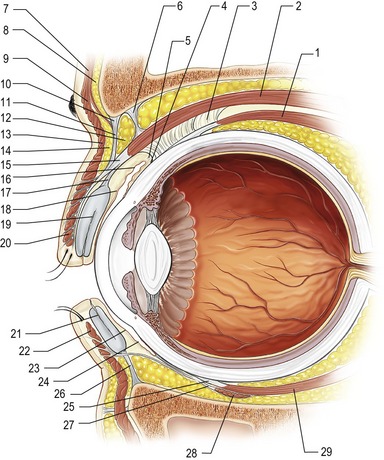CHAPTER 32 Tarsal strip canthoplasty
History
Suspension of the tarsus of the lower eyelid was originally described by Lexer and Eden in 1911.1 Since that time, multiple modifications have been made, most notably by Tenzel,2 Anderson and Gordy,3 Whitaker4 and Ortiz-Monasterio and Rodriguez.5 Alteration in the contour and position of the lower eyelid carries many names. It has been described as the tarsal strip procedure, the lateral canthal sling, lateral canthopexy, lateral canthoplasty, the tarsal tongue, the periosteal strip, horizontal shortening and tarsal suspension.6 While initially described for treatment of functional malposition of the eyelid, current use of the tarsal strip procedure includes many aesthetic adaptations.
Physical evaluation
• Attain a thorough history of ocular and eyelid symptoms, past medical and ocular history (with particular attention to the presence of rosacea, blepharitis, or other cicatricial diseases and thyroid associated orbitopathy) and past surgical history (with attention to any history of prior eyelid or facial cosmetic surgery and trauma).
• Check visual acuity in each eye.
• Examine the contour and position of the lower eyelid – evaluating the distance of the center of the mid-pupillary light reflex to the lower eyelid margin (MRD2) and the presence of inferior scleral show from lower eyelid retraction, ectropion or lower eyelid laxity.
• Determine the cause of lower eyelid malposition by examining for cicatricial changes (cicatricial etiology), facial asymmetry from seventh nerve palsy (paralytic etiology) or, most commonly, excessive laxity (involutional etiology).
• Evaluate lower eyelid laxity with the eyelid snapback test and the eyelid distraction test. The eyelid snapback test is performed by distracting the lower eyelid inferiorly toward the inferior orbital rim. Normal snapback occurs spontaneously. Quantification of abnormal lower lid laxity can be ascertained by counting the number of blinks required for the lid to return to its normal position against the globe. The eyelid distraction test is an estimation of the distance the lower eyelid can be pulled directly off of the globe.
• Ascertain the risk of developing or presence of keratopathy by assessing lagophthalmos during gentle closure and the presence of punctate corneal fluorescein staining (superficial punctate keratopathy).
• Manually elevate and retroplace the lower eyelid at the lateral canthus with a single digit to determine if tarsal shortening and suspension alone will result in adequate lower eyelid shape, contour and position against the globe.
Technical steps
Anatomy
Structurally, the eyelid is divided into anterior, middle and posterior lamellae. The anterior lamella is comprised of skin and orbicularis oculi muscle. The middle lamella contains orbital septum and orbital fat. The posterior lamella of the lower eyelid is made up of tarsus, lower eyelid retractors (capsulopalpebral fascia and inferior tarsal muscle) and conjunctiva. In fashioning a tarsal strip, the anterior and posterior lamellas are split. See Fig. 32.1 for a summary of relevant eyelid and periocular anatomy.
The normal slope of the lower eyelid is slightly upward from medial to lateral, placing the lateral canthus approximately 1–2 mm above the medial canthus. When the lateral canthal angle is lower than the medial canthal angle, this is termed an anti-mongoloid slant. An excessive upward slant of the lateral canthal angle is known as a mongoloid slant. While traumatic lateral canthal dystopia and syndromes can account for these alterations, normal variants are more common. Examination of a patient from the side allows comparison of the anterior aspect of the globe to the lower eyelid and malar eminence. If a negative vector exists, canthal surgery can result in tethering of the eyelid beneath a prominent globe.7 Since both symmetry and stability of facial appearance are important components of any lower lid repositioning procedure, photographs of the patient at a younger age often aid in determining what is “normal” for that individual.
Lateral tarsal strip technical steps
4. Release the orbital septum.
6. Opening of a periosteal slot.
9. Lateral canthal angle reformation.
A number 15 blade is used to create a lateral canthal incision in an aesthetically pleasing skin fold of approximately one centimeter (Fig. 32.2A,B). With upward traction on the lateral aspect of the lower eyelid, the inferior crus of the canthal tendon is severed with Stevens scissors (Fig. 32.3A,B
Stay updated, free articles. Join our Telegram channel

Full access? Get Clinical Tree









